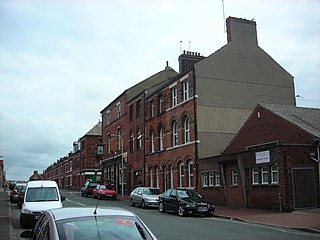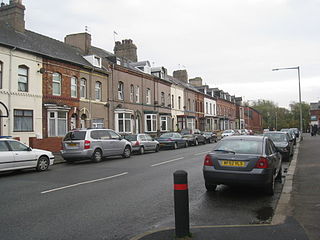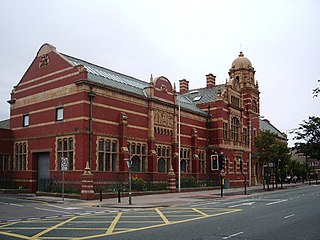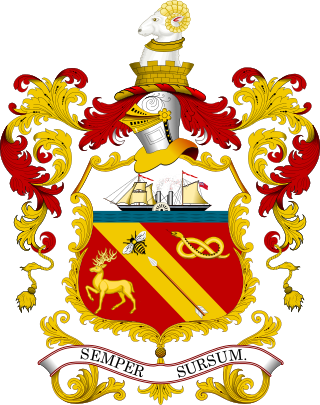
Barrow-in-Furness is a port town in Westmorland and Furness, Cumbria, England. Historically in Lancashire, it was incorporated as a municipal borough in 1867 and merged with Dalton-in-Furness Urban District in 1974 to form the Borough of Barrow-in-Furness. In 2023 the borough merged with Eden and South Lakeland districts to form a new unitary authority; Westmorland and Furness. At the tip of the Furness peninsula, close to the Lake District, it is bordered by Morecambe Bay, the Duddon Estuary and the Irish Sea. In 2011, Barrow's population was 56,745, making it the second largest urban area in Cumbria after Carlisle, and the largest in Westmorland and Furness. Natives of Barrow, as well as the local dialect, are known as Barrovian.

Barrow Island is an area and electoral ward of Barrow-in-Furness, Cumbria, England. Originally separate from the British mainland, land reclamation in the 1860s saw the northern fringes of the island connected to Central Barrow. Barrow Island is also bound to the south and east by the town's dock system and to the west by Walney Channel. The Ward population taken at the 2011 census was 2,616.

Portland Walk is a shopping centre in Barrow-in-Furness, Cumbria, England. Constructed in 1998 on the site of the former Forshaw Street, it was designed as a modern extension to Dalton Road; Barrow's principal shopping district. Barrow Indoor Market is also located adjacent to the southern entrance of the centre. Portland Walk has a total retail floor area of around 200,000 sq ft (19,000 m2) and contains over 30 stores and services. The complex is entirely open-air, however, there has been unsuccessful proposals to cover it with a roof. A 500-space multi-storey car park provides direct access to the centre.

Central Barrow refers both to the town centre of Barrow-in-Furness, Cumbria, England and to the electoral ward that roughly covers the eastern part of that town centre. In 2001 5,584 lived in the Central ward. The population density was 55.96 per hectare, which was well above the local average of 9.24, and England average, 3.77. The population of Central ward had reduced to 4,583 at the 2011 Census.

Hindpool is an area and electoral ward of Barrow-in-Furness, Cumbria, England. It is bordered by Barrow Island, Central Barrow, Ormsgill, Parkside and the Walney Channel, the local population stood at 5,851 in 2011. The ward covers the entire western half of the town centre and includes Barrow's main shopping district. Other local landmarks include the Furness College Channelside campus, the Dock Museum and the Main Public Library. Hindpool is also home to two stadia - Barrow Raiders' Craven Park and Barrow A.F.C.'s Holker Street.

Abbey Road is the principal north to south arterial road through Barrow-in-Furness, Cumbria, England.
There are 274 listed buildings in the Borough of Barrow-in-Furness, with about 70% in Barrow-in-Furness itself. The 2015 Heritage Index formed by the Royal Society of Arts and the Heritage Lottery Fund placed the Borough as seventh highest of 325 English districts with an especially high score relating to industrial heritage assets. The Barrow Island conservation area contains dozens of historic shipyard buildings and tenements, while numerous listed buildings can be found lining Abbey Road and Duke Street, which were designed as the principal north to south and east to west thoroughfares of the Victorian planned town. Despite many buildings and structures dating from this era, an abundance of listed buildings exist throughout the Borough that pre-date Barrow, in villages that were consumed by the rapidly expanding town. One notable example being Newbarns village which retains its original 18th century street layout. Significant clusters of listed buildings can be found around the ruins of the 12th-century Furness Abbey and Market Street, the Medieval centre of Dalton-in-Furness. The oldest listed building in Barrow is Furness Abbey, dated 1127 and the newest is the John Whinnerah Institute, completed in 1934.

Parkside is an area and electoral ward of Barrow-in-Furness, Cumbria, England. It is bordered by Hindpool, Ormsgill, Hawcoat, Newbarns and Risedale and had a population of 5,742 in 2001, reducing to 5,584 at the 2011 Census. It is one of the town's most centralised wards and contains Barrow's main park, as well as the newly established Furness Academy.

The Hindpool Retail Parks are a set of four conjoined retail parks in the Hindpool area of Barrow-in-Furness, England, United Kingdom. Some thirty stores and leisure facilities contain a total of 43,000 m2 (460,000 sq ft) of retail space. The four retail parks are Cornerhouse Retail Park, Cornmill Crossing, Hindpool Retail Park and Hollywood Park. The largest and only other retail park in Barrow is Walney Road Retail Park - Pound Stretcher, Argos Extra, Asda, Home Bargains, Matalan and Stollers.

The Nan Tait Centre is a Grade II listed building located at Abbey Road in the Hindpool area of Barrow-in-Furness, Cumbria, England.

The Furness Abbey Hotel was demolished in 1953, having been bombed in May 1941. Its site now forms the car park to Furness Abbey and the museum. The station at Furness Abbey also suffered bomb damage and was demolished in the early 1950s. The original station booking office and refreshment room, built in 1862, which had been attached to the hotel, survives as The Abbey Tavern, standing in Abbey Approach, Barrow-in-Furness, Cumbria, England, to the north of the remains of Furness Abbey. The current structure is recorded in the National Heritage List for England as a designated Grade II listed building.

The Barrow Jute Works was a jute and flax mill located in Barrow-in-Furness, Lancashire, England during the late 19th and early 20th centuries. The mill was built for the Barrow and Calcutta Jute Company which was founded by James Ramsden in 1870 in an attempt to diversify Barrow's economy which was heavily focused on iron and steel production. The Jute Works itself was designed by architects Paley and Austin and occupied over 12-acres with a 580 feet (177 m) facade on Hindpool Road and 360 feet (110 m) along Abbey Road. The mill was served by its own railway station on a branch of the Furness Railway which connected it to the town's docks, steelworks and cornmill.

Abbot's Wood was a large country house and estate located to the north-northeast of Barrow-in-Furness, Cumbria, England. It was sited on elevated ground to the northeast of Furness Abbey. The house was surrounded by extensive grounds with footpaths providing fine views.

The Custom House in Barrow-in-Furness, Cumbria, England is a former government building, having housed the customs offices for trade handled at the Ports of Barrow and Lancaster. Initially constructed as a hotel around 1870, it took on its most notable role as a custom house in 1880, regulating custom from the Port of Lancaster.
St. George's Square, in Barrow-in-Furness, Cumbria, England is a public space that acted as the centre of the town during the late 19th century. The square now lies in the southernmost fringes of the Central ward close to the Port of Barrow.

Oxford Chambers is a Grade II listed building located on Abbey Road in Barrow-in-Furness, Cumbria, England. Oxford Chambers was constructed in 1875 with the intention of it functioning as a commercial property, however the new town's first higher grades school opened within the building in 1880. The school relocated to a larger premises on Duke Street in 1889. A notable feature of the building is a sign reading 'Central Cigar Depot', it also housed a shop selling office supplies in the late 20th century. Despite this, it is most known for containing the extension of the adjacent Travellers Rest social club. Oxford Chambers lies at the very northern perimeter of the Central Barrow conservation area close to The Duke of Edinburgh Hotel and the neighbouring Cooke's Building.

Ramsden Square is a square located at the intersection of Abbey Road and Duke Street in Barrow-in-Furness, Cumbria, England. It marks the boundary of the Central and Hindpool wards and now acts as a major roundabout. Ramsden Square was first laid out in the 1840s to act as a focal point of Sir James Ramsden's master plan for the new town of Barrow, separating its burgeoning industries and commercial core. The centerpiece of the square is a statue of Ramsden himself while it is framed by a number of historic buildings including Barrow Central Library, the National Westminster Bank Building and formerly the Barrow Jute Works.

The coat of arms of Barrow-in-Furness was the official symbol of Barrow Borough Council, the governing body of the Borough of Barrow-in-Furness, England. The arms were officially granted on 13 December 1867 to the County Borough of Barrow-in-Furness. Upon the amalgamation of the County Borough and adjacent Dalton-in-Furness Urban District on 16 April 1975 the arms were adopted by the Barrow Borough Council.
















